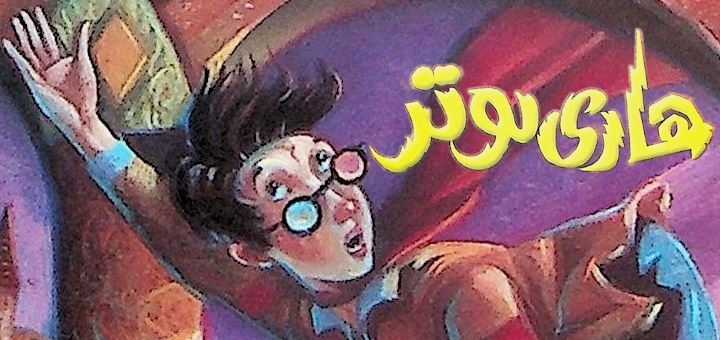 Harry Potter and the Ever-Transfigured Arabic Translation
Harry Potter and the Ever-Transfigured Arabic Translation
It is my pleasure to welcome a guest contributor to potterglot.net, Baldur Babbling, the author of the site Potter of Babble (@baldurbabbling). Not only is he a fellow translation enthusiast and collector, he is an expert in Middle-Eastern languages and literature. When Baldur started comparing Arabic editions of Philosopher’s Stone that we had here-to-fore believed to be identical and started to find big differences between them, it was clear to me that he was the best person to present his findings and I am delighted that he accepted my offer to publish them here. I have added a few of my own thoughts separately in another article, Harry Potter and the Morphing Arabic Translator—but this is the main event! If you can only read one article, read this one and if you read them both, read this one first!
There’s been a bit of chatter lately among collectors about the Arabic editions of Harry Potter and the Philosopher’s Stone. By comparing copies, we discovered they’re not uniform! Different editions even list different translators. So what does that mean if you’re a Harry Potter translation collector? Are there now multiple Arabic translations to collect? If they’re not separate translations, what’s the difference? And is one better than the other? Which one should I have?
In the article below, I’ll begin with a very brief discussion about Arabic and its magical history of translation (including its role in the legend of the Philosopher’s Stone). Then, I’ll introduce how we, as a community, were able to identify three different versions of Philosopher’s Stone in Arabic. After that, I’ll discuss how we can say with confidence that there is only one (yes, one!) translation in three macroeditions, before delving into how drastically they still differ nonetheless. (Indeed, some collectors may want multiple macroeditions in their collection given how different they are!) Finally, I’ll show you how you can tell for yourself which macroedition you have.
ᴛᴀʙʟᴇ ᴏꜰ ᴄᴏɴᴛᴇɴᴛs
Before we begin, I’d like to thank everyone who aided in this research by sending along snapshots of their Arabic books! This would have been an impossible endeavor without your help. And a special shout out to @aroundtheworld_withharrypotter, who first noticed the disparities and brought this to our attention, and to Potterglot again for his own research and insight, and for the several late night conversations we had about our findings—and apparently while he was ailing from a plague!
Ah, Arabic! The Language of Alchemists and the Philosopher’s Stone
Arabic is a magical language. Literally. Genies and ghouls are mainstays of early Arabic literature. The 9th-century Banu Musa brothers invented a flute that plays itself. Alchemy (from Arabic: al-khimiyyāʾ), at its finest, was an Arab endeavor. The search for the “philosopher’s stone” reached its zenith with Geber¹—or Jabir. The stone’s elixir (Arabic: al-iksīr) was first described in Arabic.
But it’s also magical literally.
Just over a century after the dawn of Islam, Arabic tore down the walls between peoples from Greece to Syria to Persia. Each of those regions were hosts to intellectual centers, and now their scholars were free to travel, interact, and debate with one another.
Arabic was the new lingua franca that united them, regardless of faith, ethnicity, or native tongue.² A translation movement emerged in Baghdad, carried out on an industrial scale, and fueled the intellectual movement. It also spurred the most rapid flourishing of literature until modern times.
Expression took on such particularity that words had to be coined left and right to lend the most subtle of nuance, creating perhaps the largest vocabulary of any language ever.³ Arabic, a language that for centuries was reputed as the dialect of desert bumpkins, became the very epoch of eloquence. To master the language was to tap into the wisdom of the divine… and to harness power over nature.
How We Discovered Three Arabic Macroeditions
So it’s all but fitting that the magical world of Harry Potter would exist in Arabic, and all the more that the series should begin with the famed Ḥajar al-faylasūf (the Philosopher’s Stone).⁴ When we thumb through the first edition of the Arabic translation, the anglicisms fade away into the background of its splendor, as we’re immersed into the lexicon of the ancient writers and the intertextuality of Arabic’s rich literary tradition. The magic comes not from the names or motifs highlighted by the translator—although we do see some of that, such as the unleashing of an all-powerful genie in the dungeon—but from word choice, sentence structure, and the linguistic reinterpretation of whole segments. And it often happens in the subtlest of ways: “The Man With Two Faces” becomes Dhū al-Wajhāyn, a construction that’s both natural to Arabic and calls to mind the legendary Dhū al-Qarnayn, “He With Two Horns,” a mighty leader who once conquered the ends of the earth.
The tale of Harry Potter is transformed in this translation—perhaps too much, to the point that it needed substantial revision as the series grew, alongside its worldwide following.
Those revisions allow us to count three macroeditions. I refer to them as the Original (“O”), Source-Orienting (“S.O.”), and Standardizing (“S”) macroeditions, terms that will be explained later.
The story behind this present post begins when @aroundtheworld_withharrypotter obtained a second copy of Harry Potter in Arabic and realized the text in the two copies did not match. The differences were already apparent in the very first sentence.
| Source-Orienting (Arabic) | تفخر أسرة (درسلى) التى تقيم فى المنزل رقم أربعة بشارع (بريفت درايف) بأنها أسرة طبيعية تمامًا |
| Standardizing (Arabic) | يفخر السيد والسيدة (درسلي) المقيمان في المنزل رقم (4) شارع (بريفت درايف) بأن يقولا إنهما أسرة طبيعية تمامًا |
| Source-Orienting (Transliteration) | tafkharu usratu (Darslī)⁵ allatī tuqīmu fī l-manzili raqmi arbaʿah bi-shāriʿi Brīfet Drāyf bi-annahā usratun ṭabīʿatun tamāman |
| Standardizing (Transliteration) | yafkharu l-sayyidu wa-l-sayyidatu (Darslī) al-muqīmāni fī l-manzili raqmi arbaʿah bi-shāriʿi Brīfet Drāyf bi-an yaqūlā innahumā usratun ṭabīʿatun tamāman |
| Source-Orienting (Translation) | The (Dursley) family, who lives in house number four on (Privet Drive) street, is proud that they are a totally typical family |
| Standardizing (Translation) | Mr. and Mrs. (Dursley), the residents of house number four on (Privet Drive) street, are proud to say that they are a totally typical family |
| English original | Mr. and Mrs. Dursley, of number four Privet Drive, were proud to say that they were perfectly normal |
The primary difference between these sentences is in the subject: “The Dursley family” and “Mr. and Mrs. Dursley.” Most of the other changes are grammatically tied to the change in subject.
“Mr. and Mrs. Dursley,” of course, is the subject in the original English text. So why does the older copy contain “The Dursley family” instead? The answer is probably because it’s idiomatically and grammatically simpler. On the latter point, “Mr. and Mrs. Dursley” makes the subject dual in number, a number which is marked in Arabic on nouns, verbs, and adjectives.⁶
But that wasn’t the end of our discovery!
Our very own Potterglot brought to our attention another variant—a pirated PDF scan that was available online in the mid-00s. Unfortunately the scan doesn’t include the cover or copyright page so it was difficult to identify. However, we did manage to conclusively determine that it is a scan of an early copy of the authorized translation.
| Original (Arabic) | تفخر أسرة (درسلى) والتى تقيم فى المنزل رقم 4 بشارع (بريفت) بأنها أسرة طبيعية |
| Original (Transliteration) | tafkharu usratu (Darslī) wa-llatī tuqīmu fī l-manzili raqmi arbaʿah bi-shāriʿi (Brīfet) bi-annahā usratun ṭabīʿah |
| Original (Translation) | The (Dursley) family, who lives in house number four on (Privet) street, is proud that they are a typical family |
It drops two words found in the Source-Orienting edition: “Drive” and “totally.”
But it doesn’t stop there. This third variant drops words and phrases throughout the first page (and indeed the rest of the book).
Then in the fourth paragraph, we already see some broad changes. Below is a selection from that paragraph, with excerpts from the English source at the bottom.
| Original (Arabic) | لديها أيضا سر.. سر عميق.. <…> وسرهم هو (عائلة بوتر) والتي هي على عكسهم تماما.. ورغم أن السيدة (درسلى) هى شقيقة السيدة (بوتر).. <…> لديها طفلاً ضغيراً.. هو سبب آخر في تباعدهم، حتى لا يختلط (ددلى) بابن شقيقتها السيدة (بوتر) |
| Source-Orienting (Arabic) | لديهم ايضًا سرًّا.. سرَّا خطيرًا.. <…> وسرهم هو عائلة (بوتر).. ورغم أن السيدة (درسلى) والسيدة (بوتر) شقيقتان.. <…> أختها وزوجها التافه كانا على عكسهم تمامًا <…> لديهما ايضًا طفلاً صغيرًا لم يروه قطُّ من قبل.. إلا أنه كان سببًا أخر مهمًّا في تباعدهم؛ حتى لا يختلط (ددلى) بطفل مثل هذا |
| Standardizing (Arabic) | لديهم ايضًا سرًّا.. سرَّا خطيرًا.. <…> لم يعتقدوا أن بإمكانهم تحمل فكرة أن يعرف أحد شيئًا عن عائلة (بوتر).. ورغم أن السيدة (درسلى) والسيدة (بوتر) شقيقتان.. <…> أختها وزوجها الذي لا يصلح لشيء كانا يختلفان عنهما تمامًا <…> لديهما ايضًا طفلاً صغيرًا لم يروه قطُّ من قبل.. إلا أنه كان سببًا أخر مهمًّا في تباعدهما؛ حتى لا يختلط (ددلى) بطفل مثل هذا |
| Original (Transliteration) | ladayhā ayḍan sirrun.. sirrun ʿamīqun.. <…> wa-sirruhum huwa (ʿāʾilatu Būtir) wa-llatī hiya ʿalā ʿaksihim tamāman.. wa-raghmi an al-sayyidata (Darslī) hiya shaqīqatu l-sayyidati (Būtir).. <…> ladayhā ṭiflan ṣaghīran.. huwa sababun ākhiru fī tabāʿudihim, ḥatā lā yakhtaliṭu (Dādlī) bi-bni shaqīqatihā l-sayyidati (Būtir) |
| Source-Orienting (Transliteration) | ladayhā ayḍan sirran.. sirran khaṭīran.. <…> wa-sirruhum huwa ʿāʾilatu (Būtir).. wa-raghmi an al-sayyidata (Darslī) wa-l-sayyidata (Būtir) shaqīqatān.. <…> ukhtuhā wa-zawjuhā al-tāfihu kānā ʿalā ʿaksihim tamāman <…> ladayhumā ayḍan ṭiflan ṣaghīran lam yarawhu qaṭṭu min qabli.. illā annahu kāna sababan ākhira muhimman fī tabāʿudihim, ḥatā lā yakhtaliṭu (Dādlī) bi-ṭiflin mithla hādhā |
| Standardizing (Transliteration) | ladayhā ayḍan sirran.. sirran khaṭīran.. <…> lam yaʿtaqidū an bi-imkānihim taḥmala fikratun an yaʿrifa aḥadun shayʾan ʿan ʿāʾilati (Būtir).. wa-raghmi an al-sayyidata (Darslī) wa-l-sayyidata (Būtir) shaqīqatān.. <…> ladayhumā ayḍan ṭiflan ṣaghīran lam yarawhu qaṭṭu min qabli.. illā annahu kāna sababan ākhira muhimman fī tabāʿudihim, ḥatā lā yakhtaliṭu (Dādlī) bi-ṭiflin mithla hādhā |
| Original (Translation) | They also had a secret.. a deep secret.. <…> and their secret was the (Potter) family, who were the complete opposite of them.. Mrs. (Dursley) was the sister of Mrs. (Potter).. <…> She had a small child.. he was another reason to stay away from them, lest (Dudley) mix with the child of her sister Mrs. (Potter). |
| Source-Orienting (Transliteration) | They also had a secret… a dangerous secret.. <…> and their secret was the (Potter) family.. Mrs. (Dursley) and Mrs. (Potter) were sisters.. <…> Her sister and her worthless husband were the complete opposite of them <…> The two of them also had a small child whom they had never before seen.. he was another important reason to stay away from them, lest (Dudley) mix with a child like that |
| Standardizing (Transliteration) | They also had a secret… a dangerous secret… <…> They didn’t think they could bear the thought of anyone finding out anything about the (Potter) family… Mrs. (Dursley) and Mrs. (Potter) were sisters… <…> The two of them also had a small child whom they had never before seen… he was another important reason to stay away from them, lest (Dudley) mix with a child like that |
| English original | But they also had a secret <…> They didn’t think they could bear it if anyone found out about the Potters. Mrs. Potter was Mrs. Dursley’s sister <…> Her sister and her good-for-nothing husband were as unDursleyish as it was possible to be. <…> The Dursleys knew that the Potters had a small son, too, but they had never seen him. This boy was another good reason for keeping the Potters away; they didn’t want Dudley mixing with a child like that. |
The paragraph from Potterglot’s pirate scan (the Original macroedition) diverged quite a bit from the English, while the Source-Orienting and Standardizing macroeditions drifted toward the English.
So what’s going on here? We’re still piecing together the story, but it doesn’t seem they were ever published simultaneously. The scan (the Original macroedition) turns out to be the earliest, published in 2002 (hence, “Original”). The Source-Orienting macroedition appears to be a revision, undertaken as early as 2005. The revision may have been done quietly: we have not found any announcement or explanation for the revision, and the publisher has not responded to our queries.
The Standardizing macroedition appears to be another quiet revision, first printed in early 2018. This coincided with the 2017 release of an eBook edition by Pottermore, whose exclusive rights over the digital publication of the franchise gives it the ability to standardize terminology across languages.
Shortly after, Wizarding World released an audiobook. As we’ll see below, this revision was probably intended to bring the translation further in line with the English original.
Are Any of These a New Translation?
Many have asked about the nature of the differences between the macroeditions. Do any of them constitute a new translation? The answer is an unequivocal no.
The difference between the original and standardizing macroeditions is stark, and that may be enough to meet some folks’ criteria to collect both (or even all three). But the similarities still outnumber the differences. The common skeletal structure of one single translation is very recognizable throughout each of these editions.
How We Can Tell: Using Textual Criticism as Our Toolbox
Admittedly, the mere impressions of an Arabic speaker can leave room for doubt in the claim that this is all one translation. But the field of textual criticism gives us tools to evaluate these sorts of questions more definitively. One of those tools is the concept of Leitfehler. Leitfehler are deviations from an original text that are so unique that they’re unlikely to happen spontaneously. They’re the fingerprints of a translator. So if unique deviations show up in multiple translations, we can conclude that it was translated just once.
Let me demonstrate with an exercise. We’ll use English for both the original text and the “translations,” just for simplicity’s sake.
Let’s say we have this line in a text: Knee deep in flowers we’ll stray, we’ll keep the showers away.
Then we find the following “translations”:
A. Knee deep in flowers we’ll stray, we’ll keep the showers at bay.
B. Knee deep in flowers we’ll stray, and we’ll keep the showers away.
C. Knee to toe in flowers we’ll stray, and we’ll keep the showers away.
D. Knee to toe in flowers are we, and we’ll keep the showers at bay.
Can we detect whether any of these translations were derived from the other? Translations B, C, and D all have the word “and” inserted. But multiple translators could have easily made that insertion spontaneously. It’s not unique. It’s not a Leitfehler.
Translations A and D change “away” to “at bay.” But it’s also easy for multiple translators to come up with that spontaneously: it keeps the rhyme and carries virtually the same meaning. It’s not a Leitfehler.
But the change in C and D from “knee deep” to “knee to toe” is not a simple jump, and would probably be made just once. “Knee to toe” is thus a Leitfehler, indicating C and D are two variants of the same translation.
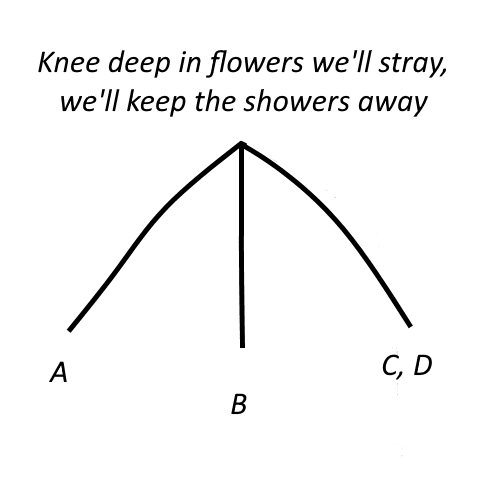
It’s not the only Leitfehler in this example, though. The change in D from “we’ll stray” to “are we,” which is counterintuitive to the rhyme and flow, is also unlikely to occur spontaneously. Since we know C and D share a Leitfehler (knee deep → knee to toe), and D has an additional Leitfehler (we’ll stray → are we), we can further conclude that D is derived from C. The original line, “Knee deep in flowers we’ll stray,” became “Knee to toe in flowers we’ll stray” (C), which in turn was changed to “Knee to toe are we” (D).
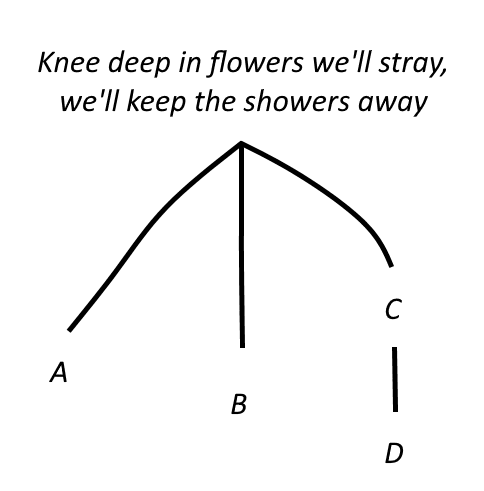
By finding similar, unlikely changes to the original translation and identifying those same changes, we can affirm that the other two macroeditions are variants of the same translation.
Identifying the Skeleton Within the Arabic Macroeditions
Let’s begin looking for Leitfehler in the Arabic translation… by again looking at the novel’s opening sentence!
The choice of tuqīmu (which I rendered in English as “reside”) is not necessarily the first word that would come to mind in translating “live.” A more literal translation would perhaps be taskunu or sākinah. In the standardizing macroedition, tuqīmu is retained, just in a grammatically adjusted form: muqīmān (that –qīm– is the common lexical stem). The odd choice of “reside” is found in all three macroeditions.
But what comes just after that first sentence is a much stronger Leitfehler, even though it’s actually different in each of the three macroeditions:
| Original (Arabic) | wa-hiya faʿlan kadhālika / وهى فعلا كذلك |
| Source-Orienting (Arabic) | wa-hum kadhālika faʿlan / وهم كذلك فعلاً |
| Standardizing (Arabic) | wa-humā faʿlan kadhālika / وهما فعلًا كذلك |
It’s not necessary to elaborate on the differences here. All three of them mean one thing: “And they were [normal] indeed.” If you check your English edition, you’ll see that clause doesn’t exist anywhere in that paragraph. It’s the translator’s attempt to interpret “thank you very much,” but they⁷ interpreted it in such a unique way that another translator would not likely come up with on their own.
Let’s take a look at a third indicator.
Recall this sentence from the Daily Prophet on the Gringotts break-in:
But we’re not telling you what was in there, so keep your noses out if you know what’s good for you.
This is actually a favorite excerpt of mine from the Arabic edition, just because the translation abandons all pretense of subtlety:
| All Macroeditions (Arabic) | لا يحاولوا معرفة ما الذى كان فى الخزانة المستهدفة إذا كانوا يريدون الحفاظ على حياتهم |
| All Macroeditions (Transliteration) | lā yaḥāwilū maʿrifata mā lladhī kāna fī l-khizānati l-mustahdafati idhā kānū yurīdūna l-ḥifāẓa ʿalā ḥayātihim |
| All Macroeditions (Translation) | No one should try to find out what was in the targeted vault, if they want to hold onto their lives. |
YIKES! How often do you get an open threat printed in a newspaper?
This line, which drifts so far away from the English original, exists unaltered in all three macroeditions.
There was a broad restructuring in this line. The translator has turned “we’re not telling you” into “no one should try to find out.” They also struggled with replicating “keep your noses out if you know what’s good for you.” So they went all out in transforming the translation entirely: “if they want to hold onto their lives.”
These examples represent merely the spectrum of Leitfehler that can be found throughout the book. Some are small and simple word choices, like tuqīmu. Others are reinterpretations that recast entire sentences, like the Gringotts statement. But they’re far from exhaustive. The number and instances of Leitfehler are pervasive throughout the book. You can open to virtually any page and find one. In fact, here’s a short one that I found just by opening at random:
Someone was lookin’ through the gap in the curtains — it’s a kid
| All Macroeditions (Arabic) | رأيت تلميذاً ينظر من خلال فتحة الستائر |
| All Macroeditions (Transliteration) | raʾaytu talmīdhan yanẓuru mina khilāl fatḥatu l-sitāʾir |
| All Macroeditions (Translation) | I saw a student looking through the gap in the curtains |
The change of subject to “I” is an improbable restructuring of the sentence. Moving “it’s a kid” to the front and changing “kid” to “student” makes it even less probable that it’s just coincidence.
So What Are The Three Macroeditions?
So now that we’ve established that these are all the same translation, how is it that they differ?
The Original Macroedition (2002–2008)
After a long search, we confirmed that the oddest was also the earliest and original. It was first printed by Nahdet Misr in July 2002 under the ISBN 977-14-1881-5 and had as many as 3 more editions. The translator is listed as Rajaa Abdullah.
It’s a gist translation⁸ that strays from the English original on nearly every page. It summarizes or abbreviates some difficult passages—and skips others completely. At the same time, it’s probably the most readable of the three macroeditions in Arabic.
Among the unique features of this macroedition:
- Hermione’s name is hīrmiyūn
- The troll in the dungeon is a jinnī jubbār, an all-powerful genie
- Uncle Vernon is referred to as ʿamm, a paternal uncle. The best way to interpret this is that he’s a paternal figure for Harry but with no blood relation. (Aunt Petunia is correctly referred to as khālah, a maternal aunt.)
You’ll see more text samples from this macroedition in the sections below, when we compare the macroeditions.
The Source-Orienting Macroedition (2008–2016)
At the time of this post, the earliest copy we’ve seen with confidence was the 4th edition printed in January 2008. It kept the same ISBN as the Original macroedition, although the translation is credited to Sahar Jabr Mahmoud instead of Rajaa Abdullah. In the 5th edition and all subsequent editions, Rajaa is again credited as the translator, with Sahar Jabr Mahmoud listed as the revisor.
I call this the “Source-Orienting” (or “S.O.”) macroedition because the revisions to the text appear intended to reorient the text toward a more literal translation⁸ of the English. It keeps a handful of oddities (like “The Dursley family” in the opening sentence) and retains a number of omissions. But otherwise the differences are drastic. There are countless instances where whole sentences are completely rewritten in order to conform to the English original. Here’s an example from Harry’s shopping list for Diagon Alley:
| Original (Arabic) | ممنوع في السنة الدراسية الأولى، أن يستعمل الأولاد عصى مكانس الآباء |
| Source-Orienting (Arabic) | نذكِّر الآباء بأن الأولاد لا يسمح لهم باستخدام عصي مكانس شخصية في السنة الأولى |
| Original (Transliteration) | mamnūʿ fī l-sinnati l-dirāsiyyati l-ūlā, an yastaʿmala l-awlādu ʿaṣī makānisi l-ābāʾ |
| Source-Orienting (Transliteration) | nudhakkiru l-ābāʾ bi-an al-awlāda lā yasmaḥu lahum bi-stakhdāmi ʿaṣiyin makānisin shakhṣiyyatin fī l-sinnati l-ūlā |
| Original (Translation) | IN THE FIRST YEAR OF STUDY KIDS’ USE OF PARENTS’ BROOMSTICKS IS PROHIBITED⁹ |
| Source-Orienting (Translation) | We remind parents that kids are not allowed to use their personal broomsticks in the first year |
| English original | PARENTS ARE REMINDED THAT FIRST YEARS ARE NOT ALLOWED THEIR OWN BROOMSTICKS |
The Source-Orienting translation does not match the English precisely. But look at the words that were restored: “remind,” “allowed,” and “personal.” There’s no doubt that the changes were intended to move toward a more literal rendering of the English sentence.
For what it’s worth, I like the original sentence formation a bit better from the standpoint of stylistic norms in Arabic writing. But the new sentence works just fine and it more accurately captures the nuance of the original English. A relatively neutral change, all things considered.
Some changes in this macroedition are less neutral. Sometimes the attempt to conform to English makes the translation so literal that it’s no longer good Arabic:
| Original (Arabic) | عرفت أنك في اجازة بعد ظهر يوم الجمعة.. فهل تسمح بأن تتناول معي الشاى فى الساعة الثالثة في بيتى |
| Source-Orienting (Arabic) | أعرف أن لديه إجازة بعد ظهر يوم الجمعة.. فهل تحب أن تأتى إلى بيتي لتتناول معي الشاى فى الساعة الثالثة |
| Original (Transliteration) | ʿaraftu annaka fī ijāzati baʿda ẓuhri yawmi l-jumʿah.. fa-hal tusmaḥu bi-an tatanāwala maʿī al-shāya fī l-sāʿati l-thālathati fī baytī? |
| Source-Orienting (Transliteration) | aʿrifu an ladayhi ijāzatu baʿda ẓuhri yawmi l-jumʿah.. fa-hal tuḥibb an taʾtiya ilā baytī li-tatanāwal maʿī al-shāya fī l-sāʿati l-thālathati? |
| Original (Translation) | I’ve found out that you’re on a break on Friday afternoons.. so would you be able to meet with me for tea at 3 o’clock at my house? (good Arabic) |
| Source-Orienting (Translation) | I know that Friday afternoon is a break.. so would you like to come to my house to meet with me for tea at 3 o’clock? (mediocre Arabic) |
| English original | “I know you get Friday afternoons off, so would you like to come and have a cup of tea with me around three?” |
Another example:
| Original (Arabic) | أما فى حجرة الملابس، فقد اتجه وود إلى هارى وقال له |
| Source-Orienting (Arabic) | وفى حجرة الملابس، أخذ (وود) (هارى) جانبًا وقال له |
| Original (Transliteration) | amā fī ḥujrati l-malābis, fa-qad ittajaha (Wood) ilā (Harry) wa-qāla lahu |
| Source-Orienting (Transliteration) | wa-fī ḥujrati l-malābis, akhadha (Wood) (Harry) jāniban wa-qāla lahu |
| Original (Translation) | When in the changing room, (Wood) had turned to (Harry) and said… (good Arabic) |
| Source-Orienting (Translation) | When in the changing room, (Wood) took (Harry) to the side and said… (mediocre Arabic) |
| English original | Back in the locker room, Wood had taken Harry aside. |
As you can see, this last example is a quite literal lexical rendering of the English. Interestingly, though, the verb tense in the Source-Orienting macroedition (i.e., “took”) has been changed away from the verb tense in the English sentence (i.e., “had taken”).
But sometimes something worse happens than simply downgrading the quality of Arabic. Sometimes it becomes too clunky in Arabic:
| Original (Arabic) | قال أحد التوءمين: رئيس التلاميذ؟! لم أكن أعرف أنك منهم |
| Source-Orienting (Arabic) | قال أحد التوءمين وكأنه فوجئ: آه، هل أنت من رواد الفصول يا (بيرسي)؟! كان يجب أن تقول لنا. ليست لدينا أي فكرة |
| Original (Transliteration) | qāla aḥadu l-tawʾamayni: “raʾīs al-talāmīdh?! lam akun aʿrif annaka minhum!” |
| Source-Orienting (Transliteration) | qāla aḥadu l-tawʾamayni wa-ka-annahu fūjiʾa: “āh, hal anta mina rawādi l-fuṣūl, yā Bīrsī?! kāna yajibu an taqūla lanā. laysat ladaynā ayyu fikratin” |
| Original (Translation) | One of the twins said: “President of the student body?! I didn’t know you were one of those!” |
| Source-Orienting (Translation) | One of the twins said, as if he were surprised: “Oh, are you among the class mentors, Percy? Would that you had told us. We had not had the slightest of ideas.” |
| English original | “Oh, are you a prefect, Percy?” said one of the twins, with an air of great surprise. You should have said something, we had no idea.” |
I took a little freedom in translating the Arabic of that last example, but I did so to bring out how relatively clunky it reads. The passage in the Source-Orienting macroedition is grammatical and easy to understand, but it’s also very formal, measured, and unable to reproduce the intended humor (which the Original macroedition had, in fact, captured).¹⁰
Of course, it must be mentioned that this edition does flesh out the parts that the Original macroedition had omitted.
Take for instance the Q&A between Harry and Quirrell about Snape in the final chapter. Much of that was cut from the Original macroedition, which reads roughly as:
“This mirror is the key to finding the Stone,” Quirrell murmured.
Quirrell came back out from behind the mirror and stared hungrily into it.
“I see the Stone… I’m presenting it to my master… but where is it?”
Harry struggled against the ropes binding him, but they didn’t give.
“He showed me how wrong I was. There is no good and evil, there is only power, and those too weak to seek it. He is with me wherever I go!”
He cursed under his breath. “I don’t understand… is the Stone inside the mirror? Should I break it?”
A lot was left out here, but it was all restored in the Source-Orienting macroedition.
Usually this happens on a smaller scale. Take this example from the Forbidden Forest chapter, where Hagrid explains that there’s an injured unicorn out there:
| Original (Arabic) | وعلينا العثور على وحيد القرن المصاب.. فقد نتمكن من مساعدته |
| Source-Orienting (Arabic) | وعلينا العثور على الحصان المصاب، وربما سيكون علينا قتله؛ ليرتاح من عذابه |
| Original (Transliteration) | wa-ʿalaynā l-ʿuthūr ʿalā waḥīdi l-qarni l-muṣāb.. fa-qad natamakkinu mina musāʿidatihi |
| Source-Orienting (Transliteration) | wa-ʿalaynā l-ʿuthūr ʿalā waḥīdi l-ḥiṣāni l-qarni l-muṣāb, wa-rubbama sa-yakūnu ʿalaynā qatlihi; li-yartāḥa mina ʿidhābihi |
| Original (Translation) | It falls on us to find the injured unicorn.. we may be able to help it. |
| Source-Orienting (Translation) | It falls on us to find the injured unicorn, and it may fall upon us to kill it; to relieve it from its suffering. |
| English original | “We’re gonna try an’ find the poor thing. We might have ter put it out of its misery.” |
In summary, the changes we see in the Source-Orienting macroedition bring the translation closer in line with the original English publication. In the Diagon Alley list, Hagrid’s invitation for tea, and Wood taking Harry aside, the sentences were reworded to follow the wording of the English sentences. Many omissions to the story were restored, moreover, as in Harry’s dialogue with Quirrell and in Hagrid’s explanation about the injured unicorn. But, as exemplified especially by the twin’s mockery of Percy, the changes made in this macroedition were not always nicer for the Arabic reader.
Finally, just to follow up on the bullet points from the Original macroedition:
- The spelling of Hermione’s name becomes harmiyūn.
- The jinnī jubbār (all-powerful genie) becomes a ghoul (ghūl), a mythical being from Arab lore said to be hideous and voluminous—not unlike the troll of northern European mythology.
- Uncle Vernon is still referred to as a paternal uncle. (No change.)
The Standardizing macroedition (2017–present)
The third macroedition coincides with the release of the Pottermore eBook (2017) and an associated audiobook (2018). The first edition of this macroedition had at least two prints, in January 2018 and March 2019, with the same ISBN as the previous macroeditions and the HP logo on the front cover. The second edition, first published in March 2020, has a new ISBN (978-977-14-5870-8) and the HP logo is replaced by the Wizarding World logo.
It’s very similar to the Source-Orienting macroedition and the changes are relatively subtle. In most cases, you have to look very closely to see the difference, and it’s likely that there are entire chapters that are untouched from the Source-Orienting macroedition.
I call this the “Standardizing” macroedition because it seems the revisions are intended to bring it further in line with the English version and patch holes left in the former revision. Many of these changes restore British cultural references:
| Source-Orienting (Arabic) | أمطرت السماء سيلاً من الشهب المتساقطة.. وكأنها أحد الاحتفالات التي تشعل فيها الألعاب النارية |
| Standardizing (Arabic) | أمطرت السماء سيلاً من الشهب المتساقطة وكأنهم يحتفلون بمهرجان “ليلة الشعلة” مبكراً |
| Source-Orienting (Transliteration) | amṭarat al-samāʾī saylan mina l-shahbi l-mutasāqiṭah.. wa-ka-annahā aḥadu l-iḥtifālāti llatī tushʿalu fīhā l-alʿābu l-nāriyyah |
| Standardizing (Transliteration) | amṭarat al-samāʾī saylan mina l-shahbi l-mutasāqiṭah wa-ka-annahum yaḥtafilūna bi-mahrajān “laylati l-shuʿlah” mubakkiran |
| Source-Orienting (Translation) | The sky has had a downpour of shooting stars.. as though there’s a party where fireworks are being set off |
| Standardizing (Translation) | The sky has had a downpour of shooting stars as though people are enjoying Bonfire Night festivities early |
| English original | “They’ve had a downpour of shooting stars! Perhaps people have been celebrating Bonfire Night early” |
But despite the tendency of this macroedition to restore those British-specific cultural references, there is at least one instance where a restoration is oriented towards Arab culture. It’s the “new word” that Dudley learns. It was excluded from the original and Source-Orienting macroeditions, presumably because the ungrammatical colloquialism (“Won’t!”) would not be considered acceptable in a children’s book in the Arab world.
The standardizing macroedition, now forced to conform, found a great solution. Baby Dudley learns the word “ʿayb,” a one-syllable word that naughty children hear a lot. The word literally means “shame” and is used by Arab parents to tell children that they’re misbehaving. Dudley has heard this word often, and he’s now using it with Petunia to show his disapproval:
| Source-Orienting (Arabic) | وقصت على <…> الكلمة الجديدة التي نطقها (ددلي) |
| Standardizing (Arabic) | وقصت على <…> الكلمة الجديدة التي نطقها (ددلي): عيب |
| Source-Orienting (Transliteration) | wa-qaṣṣat ʿalā <…> l-kalimati l-jadīdati llatī naṭaqahā (Dadlī) |
| Standardizing (Transliteration) | wa-qaṣṣat ʿalā <…> l-kalimati l-jadīdati llatī naṭaqahā (Dadlī): ʿayb! |
| Source-Orienting (Translation) | She told about … the new word (Dudley) had said. |
| Standardizing (Translation) | She told about … the new word (Dudley) had said: “No!” |
| English original | She told him all about … how Dudley had learned a new word (‘Won’t!’). |
Other changes to this macroedition include corrections to errors introduced in the previous revision. In the Original macroedition, Percy is described as raʾīs al-talāmīdh, “president of the student body.” This was changed in the Source-Orienting macroedition and appears in the Standardizing macroedition as rāʾid al-manzil, “house mentor.”
In the Source-Orienting macroedition, the original phrase (raʾīs al-talāmīdh) is accidentally retained in the Halloween chapter. House Mentor Percy, apparently power-hungry in the panic of the dungeon ghoul, presumptuously proclaims, “I am the president of the student body.” This is fixed in the Standardizing macroedition, where he simply points out that he is one of the house mentors.
Thus the Standardizing macroedition doesn’t significantly veer from the Source-Orienting macroedition, at least in comparison to how much the Source-Orienting macroedition differs from the Original. It restores some British references (and brings some proper nouns closer to their English counterparts), patches holes, and makes corrections, but it doesn’t significantly alter the translation strategy introduced into the Source-Orienting revision.
Now, just for the sake of illustration of the differences between the macroeditions, here’s a simple example of how one sentence has evolved through each of them:
| Original (Arabic) | انتهى من ارتداء ملابسه وتوجه إلى المطبخ |
| Source-Orienting (Arabic) | وبعد أن انتهى من ارتداء ملابسه، توجه إلى المطبخ |
| Standardizing (Arabic) | وبعد أن انتهى من ارتداء ملابسه، خرج إلى الصالة ومنها إلى المطبخ |
| Original (Transliteration) | antahā min irtidāʾi mulābisihi wa-tawajjaha ilā l-maṭbakh |
| Source-Orienting (Transliteration) | wa-baʿda an antahā min irtidāʾi mulābisihi, tawajjaha ilā l-maṭbakh |
| Standardizing (Transliteration) | wa-baʿda an antahā min irtidāʾi mulābisihi, kharaja ilā l-ṣālah wa-minhā ilā l-maṭbakh |
| Original (Translation) | He finished putting on his clothes and headed to the kitchen. |
| Source-Orienting (Translation) | After he finished putting on his clothes, he headed to the kitchen. |
| Standardizing (Translation) | After he finished putting on his clothes, he went to the hall and from there to the kitchen. |
| English original | When he was dressed he went down the hall into the kitchen. |
On a final note, let’s again compare the bullet points from the original and source-orienting macroeditions:
- Hermione’s name reaches its final form in this macroedition: harmāyinī (which sounds quite close to Hermione). It’s hard to overlook the fact that this coincided with the audiobook released by Wizarding World. The copyright owners of Harry Potter have been notoriously adamant about preserving characters’ names in translation, and so it would not be surprising if they deemed it unacceptable to pronounce Hermione’s name as harmiyūn when the audiobook came out. (Similarly, Snape’s name becomes snāyib instead of snāb as in the earlier macroeditions.)
- Uncle Vernon is finally made into a khāl, a maternal uncle (or, in context: the husband of a maternal aunt).
- The translation of the dungeon troll as a ghūl sticks. (No change.)
How Can I Tell Which Macroedition I Have?
The safest way to tell is to look at the first page of text. Don’t read Arabic? Don’t worry. Just compare with these images with your copy:
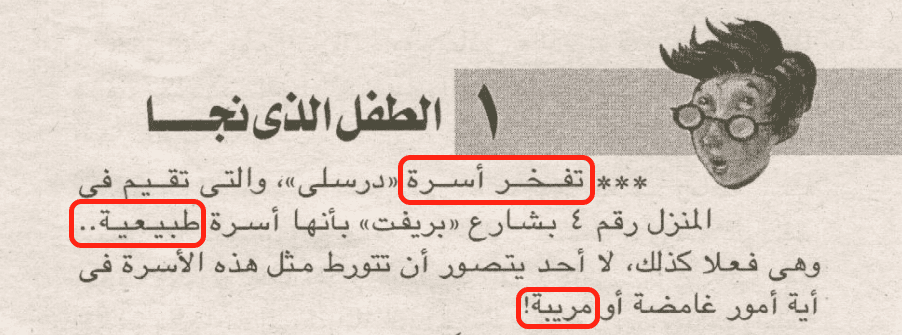
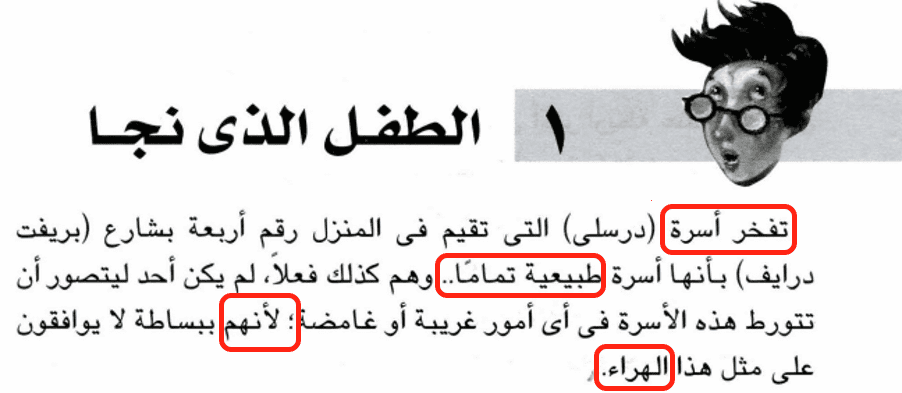
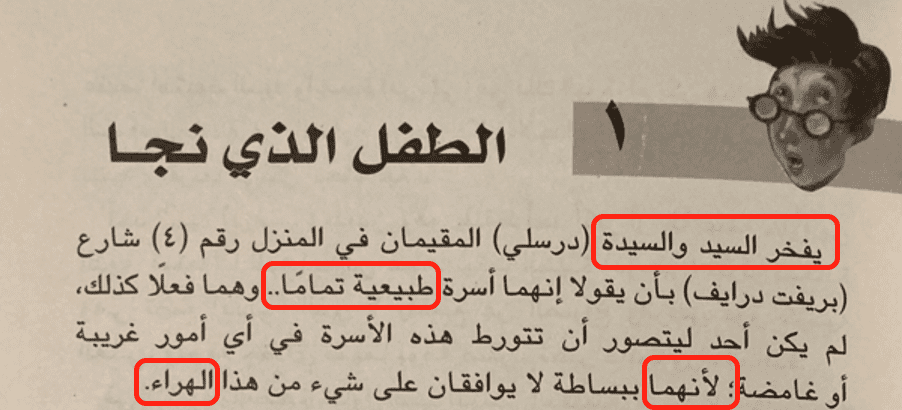
Each of the boxed words occurs at the beginning or end of the paragraph, or next to punctuation, making them easier to spot in your copy at home. Make sure that all the boxes match, not just one or two.
Potterglot also pointed out that the page numbers appear inside a circle in the Original macroedition (at least the editions that we’ve seen):

Compare with the Source-Orienting and Standardizing macroeditions:

Unfortunately, we haven’t noticed many consistent variations between the covers of the Original and Source-Orienting macroeditions. The Standardizing macroedition is the only macroedition to appear with the Wizarding World logo, however:
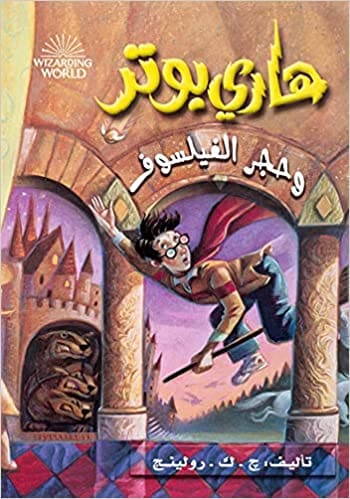
Since that’s the current macroedition in print, it’s also the most likely one you’re going to get if you buy a brand new copy.
Footnotes
¹ Jabir ibn Hayyan flourished as a chemist in 8th-century Iraq. A number of Latin texts from the 13th century on, some of which detail the philosopher’s stone and its properties and functions, claim to be his work. Their true authorship is unknown, but it is fairly certain that the content derives from the work of Arabic speakers in Al-Andalus, then the center of European science and research.
² Although Arabic was introduced to the region by an Arab Muslim ruling dynasty, they did not displace the local populations and there existed some level of religious tolerance. Instead, the local peoples learned Arabic for social mobility and access to the law. A good chunk of the literature in Arabic’s golden age was undertaken by people who spoke Arabic as their second language, especially Syriac-speaking Christian specialists and a Persian-speaking aristocracy.
³ I’m not aware of any scientific measures. An inflated claim of several million words has been floated, against just hundreds of thousands in English, the language with the second largest lexicon. Whatever the true comparison is, the takeaway matches my own firsthand impressions: I tend to tell people that, on average, there are 2 or 3 Arabic words for every English word.
⁴ The name for the stone makes way more sense in Arabic than it does in English. The faylasūf were not merely philosophers. The word in Arabic refers to the scientists of the pre-modern era. They contributed not only to philosophy, the humanities, and (indirectly) Roman Catholic theology. They were also state-of-the-art experts in medicine, mathematics, navigation, and cartography. But the faylasūf also drew criticism for their hubris, overconfident in the capabilities of the human mind. Indeed, the vain efforts of the alchemists to attain the philosopher’s stone illustrates that hubris more than anything. As a result, the word carries some negative undertones to this day.
⁵ Arabic script is a super efficient system for writing Arabic, but its efficiency can make it difficult to identify foreign words. The name “Dursley” could, for example, be easily misread as the words for “taught me.” The publisher uses parentheses throughout to signal foreign names to the reader. This practice isn’t universal in Arabic publications, but it’s certainly a helpful aid for children.
⁶ Wait. So Arabic marks when there are exactly two of something? Yes and no! Yes: literary Arabic marks when there are exactly two of something. No: spoken Arabic does not, so children are not entirely familiar with the grammar surrounding dual forms. So dropping the dual, when possible, eases the reading level for children, especially for the opening sentence.
⁷ We have not yet been able to identify whether the translator is male or female. The first name, Rajaa, is gender-neutral.
⁸ A gist translation is a translation whose phrasing deviates from the source text but carries the same underlying message. It’s the antithesis of a literal translation, which reproduces a source text word-for-word. The terms are relative: translations are rarely entirely gist or literal.
⁹ I rendered this in caps because the phrasing is reminiscent of, say, non-smoking signs.
¹⁰ Potterglot pointed out that the twin’s formal and measured taunt could be read as a mockery of Percy’s pretentiousness. I find that to be a plausible interpretation. But I think that plausibility was amplified by the fact that I’ve singled out the quotation. By singling it out, it gives the impression that the twins have changed their manner of speaking to something more pretentious. But in fact, this manner of speaking is found throughout the translation, and this example is merely intended to be a representative sample.
English-Arabic Glossary
alchemy: al-khimiyyāʾ, الخيمياء; also al-kimiyyāʾ, الكيمياء (lit. chemistry).
aunt, maternal: khālah, خالة.
ʿayb: shame, عيب. Used by parents in the Arab world to tell children they’re misbehaving.
elixir: al-iksīr, الإكسير.
genie, all-powerful: jinnī jubbār, جني جبار.
ghoul: ghūl, غول.
He With Two Horns: Dhū al-Qarnayn, ذو القرنين; learn more here (external).
Hermione: (Original) hīrmiyūn, هيرميون; (Source-Orienting) hirmiyūn, هرميون; (Standardizing) harmāyinī, هرمايني.
House Mentor: rāʾid al-manzil, رائد المنزل. Term used in the Standardizing macroedition for “prefect.”
philosopher’s stone: ḥajar al-faylasūf, حجر الفيلسوف; more traditionally ḥajar al-falāsifah, حجر الفلاسفة; learn more here (external).
president of the student body: raʾīs al-talāmīdh, رئيس التلاميذ. Term used in the Original macroedition for “prefect.”
The Man With Two Faces: Dhū al-Wajhayn, ذو الوجهين.
Rajaa Abdullah: or Rajāʾ ʿAbd Allāh, رجاء عبد الله.
Sahar Jabr Mahmoud: or Saḥar Jabr Ma︎ḥmūd, سحر جبر محمود.
Snape: (Original and Source-Orienting) snāb, سناب. (Standardizing) snāyib, سنايب.
uncle, maternal: khāl, خال.
uncle, paternal: ʿamm, عمّ.
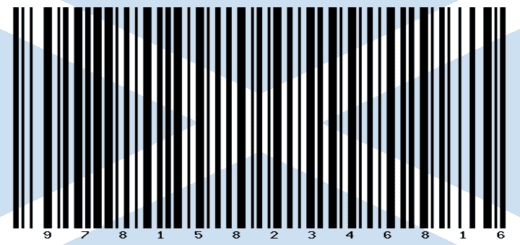



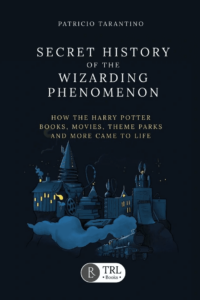


1 response
[…] edits. @baldurbabbling introduced us to the technical term for these patterns—Leitfehler—in his guest article about the Arabic translations. Judgment plays a big role and sometimes in ambiguous situations one […]